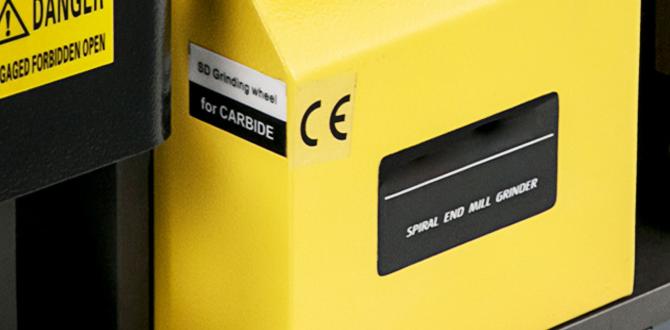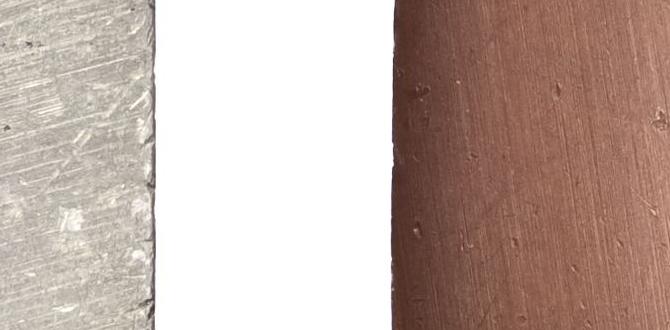Achieve proven extra-long cuts with carbide end mills by selecting the right tool for the material, using proper speeds and feeds, and employing advanced techniques like climb milling and coolant application for optimal performance and tool life.
Ever found yourself needing to reach deep into a workpiece with your milling machine, only to be limited by the flute length of your standard carbide end mill? It’s a common frustration for anyone working with metal, especially when precision matters. Trying to force a tool meant for shallow cuts can lead to chatter, poor surface finish, and even tool breakage. But don’t worry! The solution lies in understanding and leveraging the power of extra-long carbide end mills. In this guide, we’ll walk you through everything you need to know to get those deep, accurate cuts, so you can tackle more complex projects with confidence.
Understanding the Extra-Long Carbide End Mill
An extra-long carbide end mill is precisely what it sounds like: a milling tool designed with significantly longer cutting flutes than a standard end mill. This extended length allows it to reach deeper into a workpiece during a milling operation, enabling operations like deep slotting, pocketing, or profiling where the cutting tool needs to extend far beyond the holder.
Why Use an Extra-Long Carbide End Mill?
- Deeper Reach: The primary advantage is the ability to mill features that are deeper than what standard end mills can achieve. This is crucial for creating deep pockets, long slots, or complex 3D shapes.
- Reduced Setups: By using a single long end mill, you can often complete a deep feature in one operation, avoiding the need to reposition the workpiece or use multiple shorter tools. This saves time and reduces potential inaccuracies introduced by re-fixturing.
- Access to Difficult Areas: In some machining scenarios, the geometry of the part might require a tool to reach into confined spaces or around obstacles. An extra-long end mill can provide the necessary clearance.
- Material Versatility: Carbide is an excellent material for end mills due to its hardness, wear resistance, and ability to withstand high cutting temperatures. This makes carbide end mills suitable for a wide range of materials, including hardened steels, stainless steels, titanium alloys, and aluminum.
When Standard vs. Extra-Long?
Deciding between a standard and an extra-long end mill comes down to the depth of cut required and the rigidity of your setup. If your milling operation only requires cutting to a depth of 1-2 times the tool’s diameter, a standard end mill is usually sufficient and offers greater rigidity. However, when the required depth exceeds this, an extra-long end mill becomes necessary.
A key consideration when using extra-long end mills is the increased potential for tool deflection and vibration due to the longer unsupported length. This is where understanding tool characteristics and machining parameters becomes critical.
Carbide End Mill Selection for Extra Long Cuts
Choosing the right carbide end mill is paramount for successful extra-long cuts. Several factors influence this decision, especially when dealing with demanding materials like hardened steel at tight tolerances.
Key Features to Look For:
- Material: For hardened steel (HRC 60 and above), you need a highly wear-resistant carbide grade. Look for sub-micron or nano-grain carbides. These offer superior hardness and edge retention at high temperatures.
- Number of Flutes: For clearing chips in deeper cuts, especially in materials like steel that tend to produce long, stringy chips, a 2 or 3-flute end mill is often preferred. Fewer flutes allow for larger chip gullets, preventing chip recollapse and exit issues. For aluminum or softer materials, 4 flutes can be used, but for hardened steel, fewer is generally better.
- Helix Angle: A higher helix angle (e.g., 30° to 45°) can improve chip evacuation and reduce cutting forces by slicing the material more effectively. However, for very deep cuts, a lower helix angle (e.g., 20°) might offer more rigidity. For hardened steel, a moderate helix angle (around 30°) often strikes a good balance.
- Coatings: For hardened steel, coatings are almost essential.
- TiAlN (Titanium Aluminum Nitride) or AlCrN (Aluminum Chromium Nitride): These are excellent choices for high-temperature applications like milling hardened steels. They provide a hard, wear-resistant layer that can withstand the heat generated during cutting, extending tool life significantly.
- ZrN (Zirconium Nitride): Offers good lubricity and wear resistance, suitable for a wide range of materials.
- Corner Radius: A small corner radius can add strength to the cutting edge, preventing chipping, especially important in hard materials. It also helps in controlling the chip formation.
- Shank: For extra-long end mills, a larger shank diameter relative to the cutting diameter provides greater rigidity. For example, a 3/16″ (4.76mm) end mill might have a 1/4″ (6.35mm) shank. A Weldon flat on the shank is also highly recommended for better clamping in the tool holder and preventing slippage.
Example: Carbide End Mill 3/16 Inch 1/4 Shank Extra Long for Hardened Steel HRC60 Tight Tolerance
When you see a specification like this, it tells you:
- Carbide End Mill: The material of the cutting tool.
- 3/16 Inch: The cutting diameter, meaning the diameter of the actual flutes.
- 1/4 Shank: The diameter of the tool’s shank, which fits into the tool holder. This is larger than the cutting diameter, indicating a stepped design for increased rigidity.
- Extra Long: Refers to the extended flute length, allowing for deep cuts.
- Hardened Steel HRC60: The target material and its hardness. This dictates the need for specific carbide grades and coatings.
- Tight Tolerance: Implies the need for a tool that maintains dimensional accuracy and provides a good surface finish to meet demanding specifications.
Tool Holder Considerations
The tool holder plays a critical role in supporting an extra-long end mill. Standard collet chucks might not provide enough rigidity or runout accuracy for deep cuts. Consider:
- High-Precision Tool Holders: Options like hydraulic chucks or shrink-fit holders offer superior clamping force and runout accuracy, which is essential for long tools and tight tolerances.
- ER Collets with Larger Shank Support: While standard ER collet chucks are common, ensure you’re using an ER collet that provides maximum support along the shank of the end mill.
- Weldon Shank Compatibility: If your end mill has a Weldon flat, use a tool holder designed to grip this flat to prevent any possibility of rotation.
Setting Up for Success: Speeds, Feeds, and Depth of Cut
This is where the magic happens. Accurately setting your speeds, feeds, and depth of cut will dictate the success of your extra-long end mill operation. Too aggressive, and you risk breakage; too conservative, and you waste time and won’t achieve the desired results.
Understanding Cutting Speed (CS) and Spindle Speed (RPM)
Cutting speed (CS) is the surface speed at which the cutting edge of the tool engages the workpiece, usually measured in surface feet per minute (SFM) or meters per minute (m/min). Your machine’s spindle speed (RPM) is directly related to the CS and the tool diameter.
The formula is:
RPM = (CS 3.82) / Diameter (inches)
or for metric:
RPM = (CS 1000) / (π Diameter (mm))
Setting Cutting Speed (CS)
The ideal CS depends heavily on the material being cut, the tool material (carbide), any coatings, and the presence of coolant.
- Hardened Steel (HRC 60): For uncoated carbide, CS might be as low as 20-40 SFM (6-12 m/min). With TiAlN/AlCrN coatings and good coolant, you can often push this to 50-80 SFM (15-25 m/min). Always consult the tool manufacturer’s recommendations.
- Aluminum: Can handle much higher speeds, often 200-500+ SFM (60-150+ m/min).
Understanding Feed Rate (IPM or mm/min)
Feed rate is how fast the tool advances into the material. It’s usually expressed in inches per minute (IPM) or millimeters per minute (mm/min).
A critical concept here is Chip Load (CL), which is the thickness of the chip removed by each cutting edge per tooth. Too small a chip load can lead to rubbing and tool wear, while too large a chip load can cause breakage.
The formula is:
Feed Rate (IPM) = RPM Number of Flutes Chip Load (inches)
or for metric:
Feed Rate (mm/min) = RPM Number of Flutes Chip Load (mm)
Setting Chip Load (CL)
Chip load values are typically provided by the tool manufacturer and are crucial for optimal performance.
- Hardened Steel: Chip loads are generally very small. For a 3/16” (4.76mm) end mill in HRC 60 steel, a chip load might be in the range of 0.0005″ to 0.0015″ (0.012mm to 0.038mm) per tooth.
- Aluminum: Chip loads can be larger, perhaps 0.001″ to 0.004″ (0.025mm to 0.10mm) for the same size tool.
Rule of Thumb for Extra-Long End Mills: Because of the increased risk of deflection, it’s often wise to start with a chip load at the lower end of the recommended range and increase it cautiously if conditions permit.
Depth of Cut (DOC) and Stepover
This is where the “extra long” aspect comes into play. Unlike standard cuts where DOC can be 0.5x to 1x the tool diameter, for extra-long end mills, you’ll often need to reduce the DOC and stepover significantly.
- Depth of Cut (DOC): For extra-long reach, especially in hard materials, it’s common to use axial DOCs of 0.1x to 0.5x the tool diameter. For instance, with a 3/16” end mill, you might only be cutting 0.020” to 0.060” (0.5mm to 1.5mm) deep per pass in hardened steel.
- Stepover (Radial Depth of Cut): This is the amount the tool moves sideways in each pass when milling a pocket or contour. For deep pockets, a smaller stepover (e.g., 20-50% of the tool diameter) is crucial to manage cutting forces and prevent chatter. For slotting, the stepover will be equal to the tool diameter (100%).
The Importance of Rigidity
The unsupported length of an extra-long end mill makes it susceptible to deflection. This means the tool might bend slightly under cutting forces, leading to:
- Increased tool wear
- Poor surface finish
- Inaccurate part dimensions
- Chatter and vibration
- Tool breakage
To combat this, always aim for the most rigid setup possible: a high-precision tool holder, a secure workpiece, and a rigid machine tool. If possible, use end mills with a larger shank diameter than the cutting diameter and a Weldon flat.
Example Calculation (Metric)
Let’s machine a deep slot in hardened steel (HRC 60) with a 3/16” (4.76mm) diameter, ZRN coated, 3-flute carbide end mill with extra-long reach and a 1/4” (6.35mm) shank.
- Material: Hardened Steel HRC 60
- Tool: 4.76mm 3-flute carbide, TiAlN coated, extra-long.
- Manufacturer Recommendation (from catalog):
- Cutting Speed (CS): 20 m/min
- Chip Load (CL): 0.02 mm/tooth
- Calculate RPM:
- Calculate Feed Rate:
- Axial Depth of Cut (DOC): Based on recommendations for extra-long tools in hard steel, let’s start with a conservative 1.0 mm per pass.
- Radial Stepover: For slotting, this will be 100% of the tool diameter (4.76 mm).
RPM = (20 m/min 1000) / (3.14159 4.76 mm) ≈ 1337 RPM
Let’s round to 1300 RPM for simplicity and slightly less aggressive cutting.
Feed Rate = 1300 RPM 3 flutes * 0.02 mm/tooth = 78 mm/min
This is a relatively slow feed rate, but typical for this application.
This data provides a solid starting point. Monitoring the cut (sound, chip formation, surface finish) and making slight adjustments is key.
Machining Strategies for Extra Long Cuts
Beyond basic speeds and feeds, employing specific machining strategies can significantly improve the performance and longevity of your extra-long end mill.
Climb Milling vs. Conventional Milling
Climb milling (also known as down milling) is generally preferred when using extra-long end mills, especially in hard materials.
- Climb Milling: The tool rotates in the same direction as the feed. The chip starts thin and gets progressively thicker.
- Benefits: Reduces cutting forces, minimizes tool deflection, leads to better surface finish, and can reduce chatter. The tool is effectively “pulling itself” into the cut.
- Requirements: A backlash-free milling machine is crucial. If your machine has significant backlash in the feed screws, conventional milling might be safer to avoid the tool ‘digging in’ uncontrollably.
- Conventional Milling: The tool rotates against the direction of the feed. The chip starts thick and gets thinner.
- Benefits: Often more forgiving on machines with backlash. Can provide a slight’ scooping’ effect that may help lift chips.
- Drawbacks: Higher cutting forces, more tool deflection, increased potential for chatter, and often a poorer surface finish compared to climb milling.
For extra-long end mills and tight tolerances, the benefits of reduced deflection and better surface finish with climb milling often outweigh the risks, provided your machine is in good condition.
Trochoidal Milling (High-Speed Machining – HSM)
While typically associated with HSM, the principle of trochoidal milling (a series of small, overlapping circular arcs) can be beneficial even at lower speeds for deep pockets. Instead of plunging straight down and making large straight cuts, the tool follows a path that keeps chip load more consistent and manages heat more effectively.
This strategy:
- Keeps the tool engaged with a consistent chip load.
- Reduces heat buildup by constantly exposing new material and evacuating chips.
- Minimizes stress on the tool by avoiding continuous plunging.
Many CAM (Computer-Aided Manufacturing) software packages have built-in strategies for trochoidal milling and efficient pocketing that can be used with your extra-long end mill.
Ramping and Plunging Techniques
Directly plunging a long end mill straight down into hard material is often a recipe for disaster. If you must plunge:
- Use the manufacturer’s recommended plunge feed rate, which is typically much slower than the linear feed rate.
- Consider using a high-quality coolant and lubricant to reduce friction and heat during plunging.
- If possible, use a ramping motion instead of a vertical plunge. A ramp angle of 5-10 degrees is often





